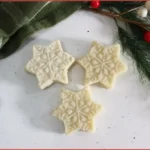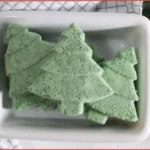Hydrosols, also known as floral waters, are aromatic waters created during the steam distillation of plants. They contain the water-soluble components of herbs or flowers and are gentle, water-based alternatives to essential oils, ideal for sensitive skin, natural skincare, and aromatherapy.
If you’ve ever spritzed rose water on your face or added a lavender mist to your bedtime ritual, you’ve already experienced the soothing world of hydrosols.

✨ Get 12 Free Holiday Diffuser Blends — Printable PDF
Instantly make your home smell like Christmas with these festive, ready-to-use recipes.
Though they’re gentler than the more concentrated essential oils, they still carry the plant’s therapeutic essence, only in a lighter, water-based form.
Their soft scent, skin-loving properties, and versatility have made them a staple in natural beauty routines, calming body sprays, and DIY self-care recipes. Incorporating hydrosols into your lifestyle is a gentle and inexpensive way to ramp up your aromatherapy experience.
Table of Contents
Affiliate Disclosure: Some links on this site are affiliate links. I may earn a small commission if you purchase through them, at no extra cost to you. See the full affiliate disclosure.
What Are Hydrosols? A Simple Explanation

Hydrosols are essentially floral waters. They are produced through steam distillation.
As the plant material is steamed, its aromatic compounds are released. While the essential oil rises and separates as a concentrated layer, the remaining water, saturated with the plant’s water-soluble components, becomes the hydrosol.
Unlike essential oils, which are highly concentrated and must be diluted before topical application, hydrosols are naturally mild and skin-friendly. They retain a soft, often herbaceous or floral scent, and are ideal for sensitive skin or daily use. Their pH is usually close to that of the skin, and they don’t carry the same risks of irritation as some essential oils do.
Though subtle, hydrosols still offer therapeutic value, especially when used fresh and stored properly. Think of them as the quiet, nurturing counterpart to essential oils, gentler, more hydrating, and effortlessly easy to incorporate into your wellness rituals.
Although hydrosols are sometimes called ‘floral waters’, they are not always the same thing. True hydrosols are made through steam distillation and contain the plant’s water-soluble components.
Some products labeled “floral water” are simply water mixed with fragrance or essential oils. These don’t have the same properties and may not be as gentle on skin. Always check the label!
How Hydrosols Are Made? The Steam Distillation Process

Hydrosols are created during the same steam distillation process used to extract essential oils.
To obtain essential oils via steam distillation, various botanicals are placed along with water in a specially designed steam distillation chamber.
When the plant parts and water are heated under pressure, they break down the cell walls. The pressure extracts the oils and water-soluble compounds from the plant parts while the heat converts the water into vapor.
These vapors, along with the extracted plant compounds, travel upward through a cooling coil, where they condense back into liquid form.
In the liquid form, the distillate separates into two parts:
- A small amount of essential oil, which floats on top.
- A larger volume of hydrosol, the aromatic water that holds the water-soluble plant compounds, along with trace amounts of essential oil.
In many cases, hydrosols are simply collected as a byproduct during essential oil production.
However, the highest-quality hydrosols are intentionally distilled to produce a well-balanced, aromatic, and therapeutic water.
The quality of a hydrosol depends on several factors, from the freshness of the plant material to the duration and temperature of the distillation.
True hydrosols are free from alcohol, synthetic fragrance, and added oils. They are just pure, distilled botanical water.
Hydrosols vs Essential Oils: What’s the Difference?
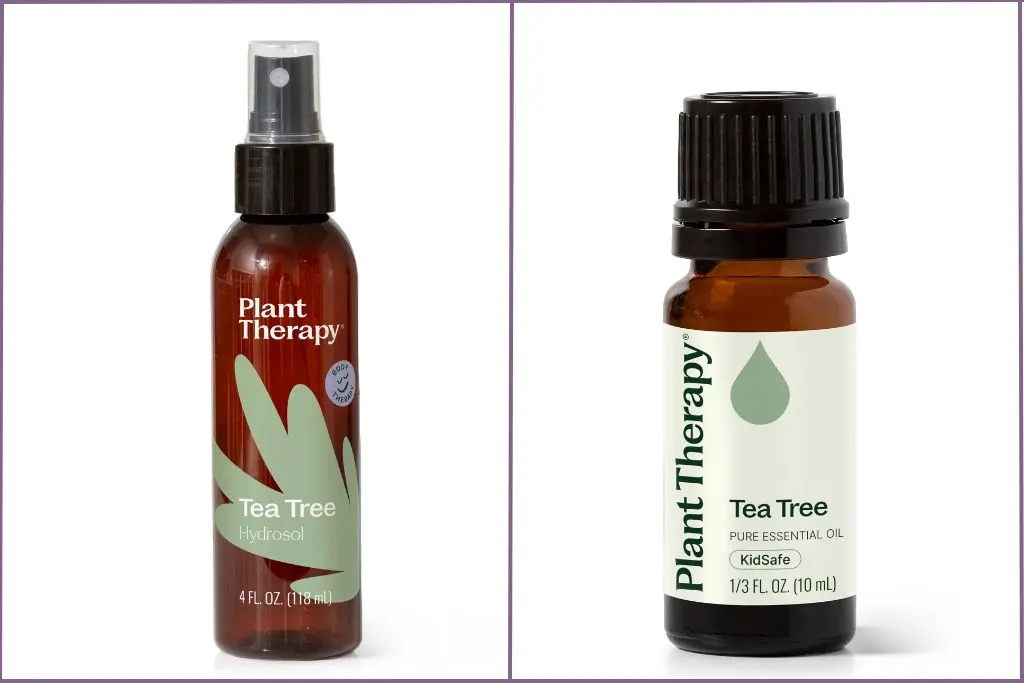
Hydrosols and essential oils may be derived from the same distillation process, but they differ in the way they look and feel. They are also different in the way they are used. Think of them as siblings, related, but with different personalities.
Essential oils obtained during the steam distillation process are highly concentrated extracts containing the potent, oil-soluble components of the plant. This concentrated nature makes them incredibly powerful, but also necessitates proper dilution before applying to the skin.
In contrast, hydrosols are far gentler, as they primarily consist of water infused with the water-soluble compounds of the plant. This makes them safe to use directly on the skin without dilution, offering a more accessible option for everyday use.
For individuals with sensitive skin or children, hydrosols provide a non-irritating alternative that still delivers many of the same therapeutic benefits, albeit in a subtler form.
Another key distinction lies in their applications. While essential oils are best suited for intensive aromatherapy practices, creating potent blends, or addressing specific concerns, hydrosols are a better option where a softer approach is desired.
Their mild aroma, combined with their compatibility with skin and hair, makes them ideal for skincare products, facial mists, and even baby care routines.
Hydrosols are also excellent for use in environments where strong scents may be overwhelming or inappropriate, such as in schools, hospitals, or around pets.
The third major difference between hydrosols and essential oils is that hydrosols can be diluted in water. This makes it easier to add hydrosols to any water-based skin care product or in the bath.
Essential oils, on the other hand, can only be diluted in carrier oil. They cannot be diluted in water because oil and water do not mix.
Here’s a simple breakdown of the key differences between hydrosols and essential oils:
| Feature | Hydrosols | Essential Oils |
| Form | Water-Based | Oil-Based |
| Concentration | Very mild with trace amounts of essential oil | Highly concentrated |
| Scent | Light, subtle aroma | Strong, potent aroma |
| Uses | Facial mists, room sprays, skin care | Diffusers, massage oils, bath blends |
| Shelf Life | 6-12 months, longer with refrigeration | 2-5 years when stored in dark-colored glass |
| Safety | Safe for most skin types | Requires caution and dilution before skin use |
Hydrosols are ideal when you want a lighter, water-compatible option for skincare or gentle aromatherapy. They don’t need to be diluted and are often safe for sensitive skin types and children.
In contrast, essential oils are powerful and concentrated. They are best used mindfully and always diluted with a carrier oil.
Rather than thinking of hydrosols as a weaker version of essential oils, it’s more accurate to see them as their own category – a fresh, water-based way to enjoy the plant’s benefits without overwhelming the senses.
5 Popular Types Of Hydrosols & Their Aromatic Qualities
Hydrosols exhibit a refreshing spectrum of scents, each rooted in the plant they come from. Exploring these varieties helps you find the perfect match for your personal routine or home. Some invite calm and relaxation, while others provide an instant mood boost. Below are some well-loved hydrosols and what makes each aroma unique.
Rose Hydrosol: Floral Luxury
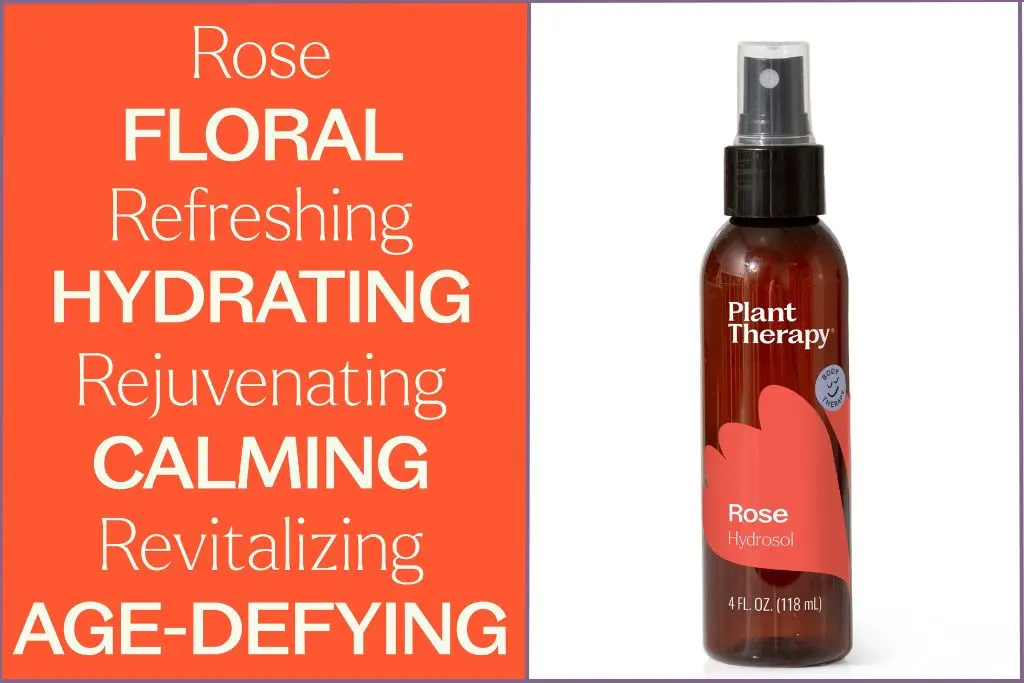
Rose hydrosol stands out as a classic. Its scent is soft, rosy, and slightly sweet, often described as comforting yet delicate. Each spray captures the feeling of fresh rose petals first thing in the morning.
In self-care routines, rose hydrosol is a favorite choice for:
• Adding a gentle touch to facial toners
• Freshening up linens and pillowcases
• Creating a calming environment with just a mist
The appeal comes from that unmistakable floral note, which feels both elegant and soothing. A bottle of rose hydrosol is like keeping a bouquet close by every day.
Its gentle floral scent makes it a favorite in skincare, where it helps hydrate and soothe the skin.
Lavender Hydrosol: Calming Botanical Mist
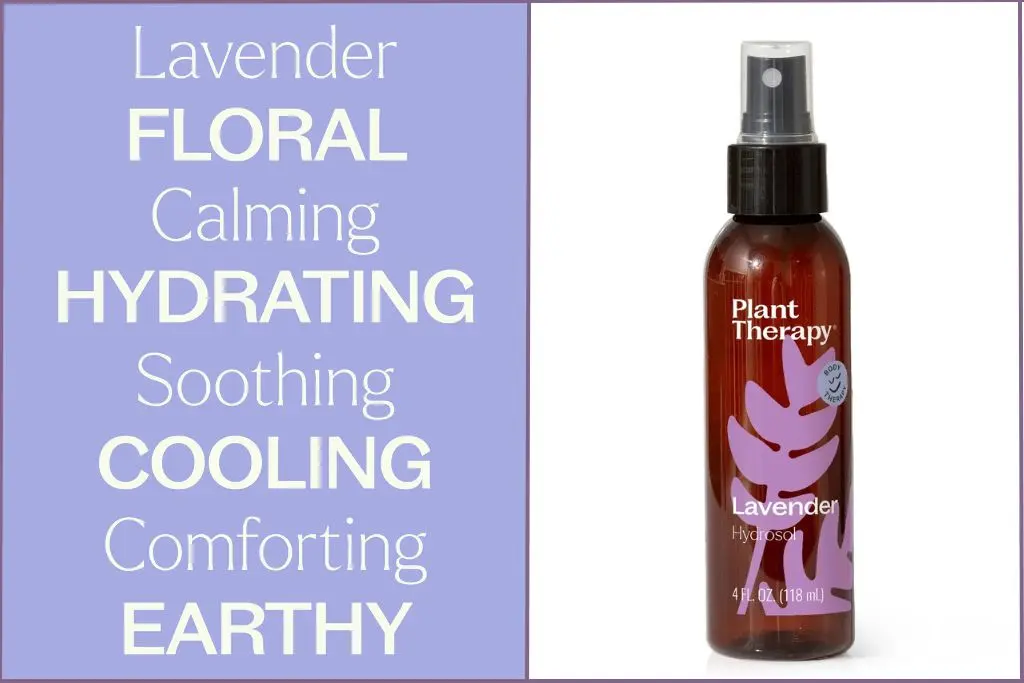
Lavender hydrosol brings the garden into your space. Its aroma is fresh, green, and herbal with floral notes and the soft, familiar touch of true lavender. Unlike heavy perfumes, this scent is light and airy, perfect for grounding your senses.
People often use lavender hydrosol to:
• Settle into relaxation at the end of the day
• Create a comforting spray for bedrooms or living rooms
• Refresh the air after housework or between activities
Its gentle scent helps turn ordinary moments into peaceful rituals, and the herbal tones blend nicely with other natural products.
Ideal for all skin types, lavender hydrosol can be used as a facial mist, toner, or after-sun spray. Lavender hydrosol also supports calmness and relaxation, making it a popular choice for adding to baths or pillow sprays.
Peppermint Hydrosol: Cool, Minty & Crisp

If you want a hydrosol that wakes you up, peppermint is a top pick. The aroma is crisp, sharp, and unmistakably minty. A few sprays cut through stuffy air and spark an instant sense of freshness.
Here’s how you can enjoy peppermint hydrosol:
• Spritzing on the face for a quick pick-me-up
• Reviving tired spaces during warm weather
• Mixing into homemade cooling sprays for post-workouts and in hot weather.
The cool, clean scent is both lively and simple. It’s an easy way to bring a little energy and brightness to your day.
Tea Tree Hydrosol: Fresh, Herbal & Purifying
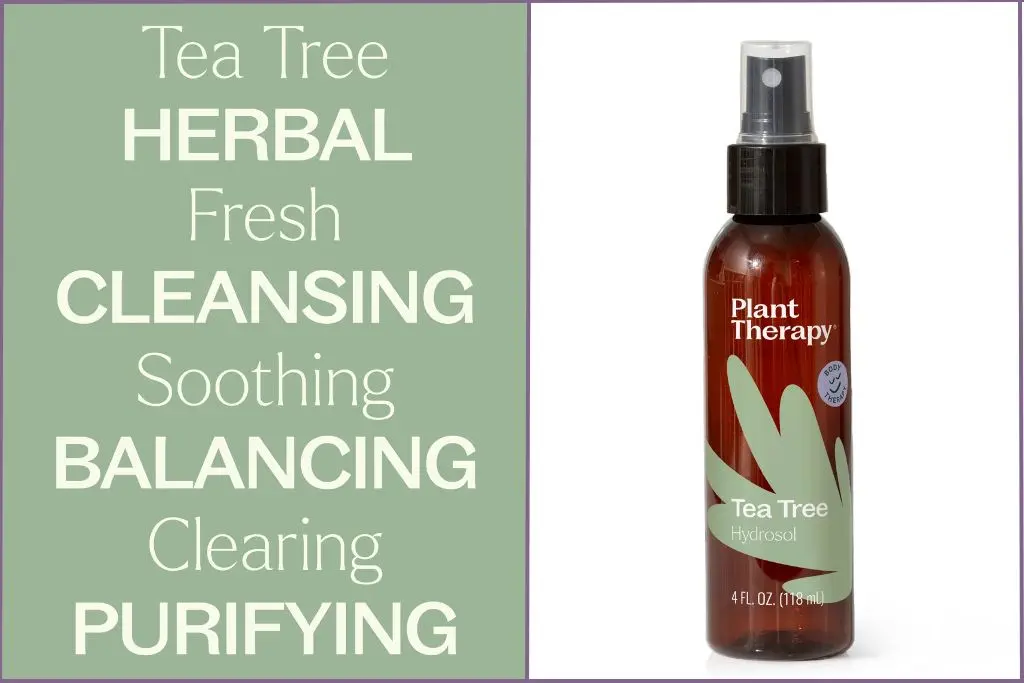
Tea tree hydrosol carries a clean, herbal scent that feels cool and invigorating. It’s known for its natural purifying properties, making it a favorite for blemish-prone or oily skin.
Here’s how many enjoy tea tree hydrosol:
• Spritzing on the face to refresh and clarify skin
• Using as a toner to help balance excess oil
• Misting on feet or gym gear for a clean scent and added freshness
Simple and effective, tea tree hydrosol delivers gentle care and a boost of clarity wherever it’s used.
Roman Chamomile Hydrosol: Soft, Sweet & Calming
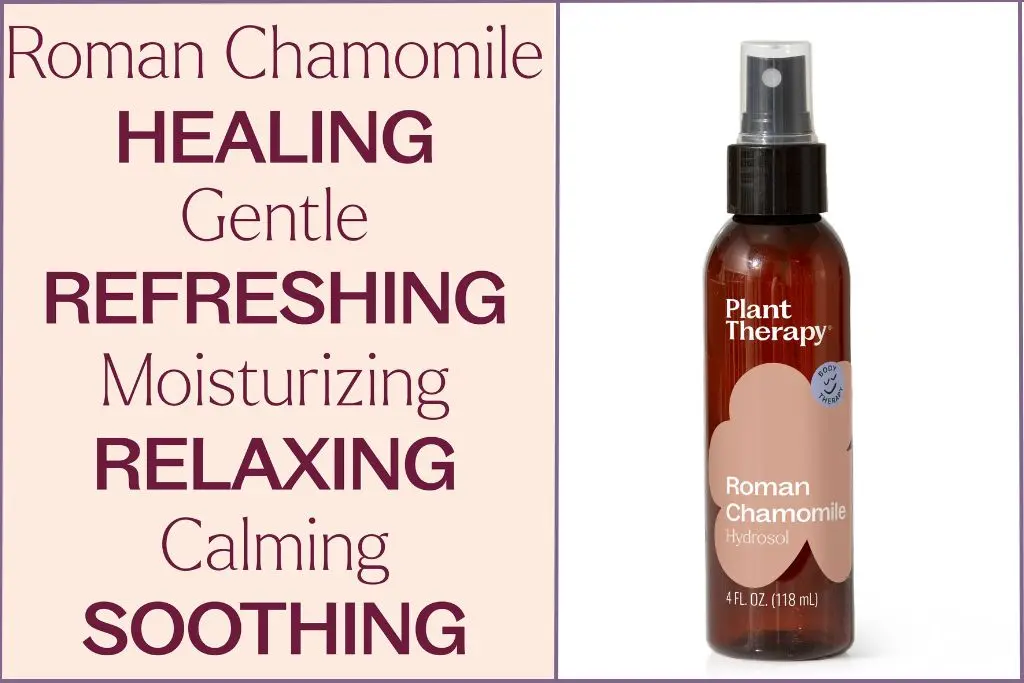
Roman chamomile hydrosol soothes with a gentle, sweet, apple-like scent. It’s a top choice for sensitive or irritated skin and for relaxing moments.
Here’s how many enjoy Roman chamomile hydrosol:
• Spritzing on the face as a calming toner
• Using in baby care routines for extra gentleness
• Adding to bathwater or compresses for comfort before sleep
This hydrosol is simple and soothing, perfect when you want a soft touch for skin and mood.
Helichrysum Hydrosol: Light, Earthy & Restorative
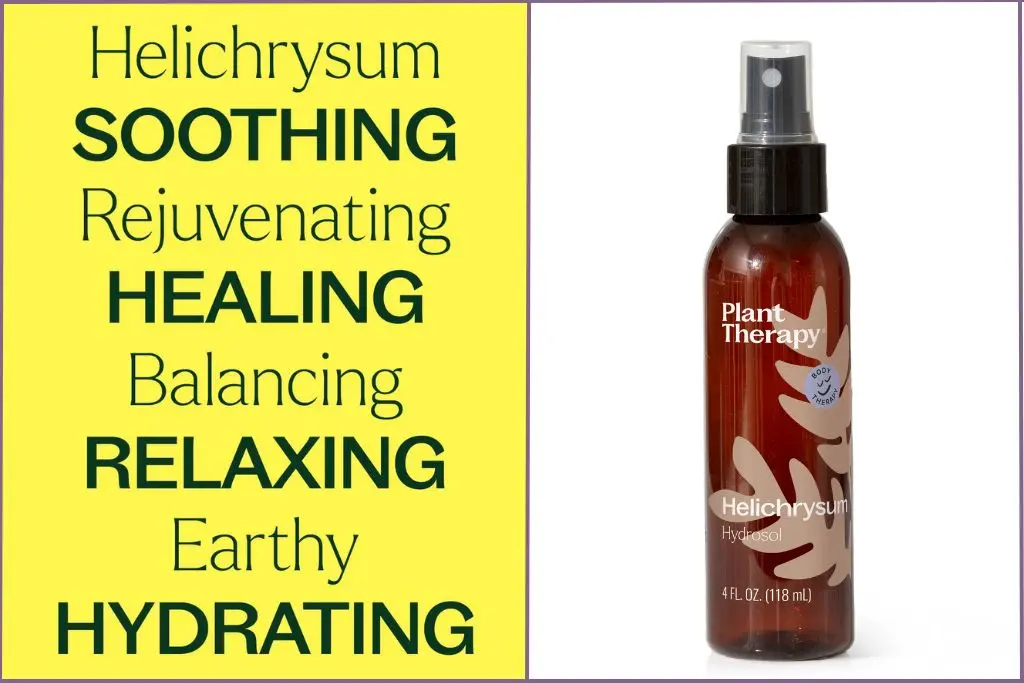
Helichrysum hydrosol, often called “immortelle water,” offers a light, earthy scent with a hint of sweetness. It’s valued for helping skin repair, calming redness, and soothing mature or sensitive skin.
Here’s how many enjoy helichrysum hydrosol:
• Spraying on sunburns, minor wounds, or irritated skin
• Using after cleansing to support skin recovery
• Misting during stressful moments for its grounding comfort
With gentle, nurturing effects, helichrysum hydrosol is a go-to for restoring both skin and spirit.
Rosemary Hydrosol: Herbal, Energizing & Clarifying

Rosemary hydrosol brings a crisp, herbal scent that feels sharp and energizing. It’s loved for its natural clarifying properties, making it a great choice for tired skin and scalp.
Here’s how many enjoy rosemary hydrosol:
Spritzing on the face for a bright, refreshing boost
Using as a scalp mist to support healthy hair and soothe itch
Adding to homemade facial toners or aftershave for extra clarity
Balanced and uplifting, rosemary hydrosol is a simple way to refresh both skin and mind throughout the day.
These hydrosols can be used on their own or combined with other ingredients in your DIY skincare and aromatherapy recipes. The best hydrosol for you depends on your skin type, scent preferences, and how you want to use it – from a calming evening spritz to a brightening morning toner.
Top Benefits of Hydrosols for Skin and Wellness
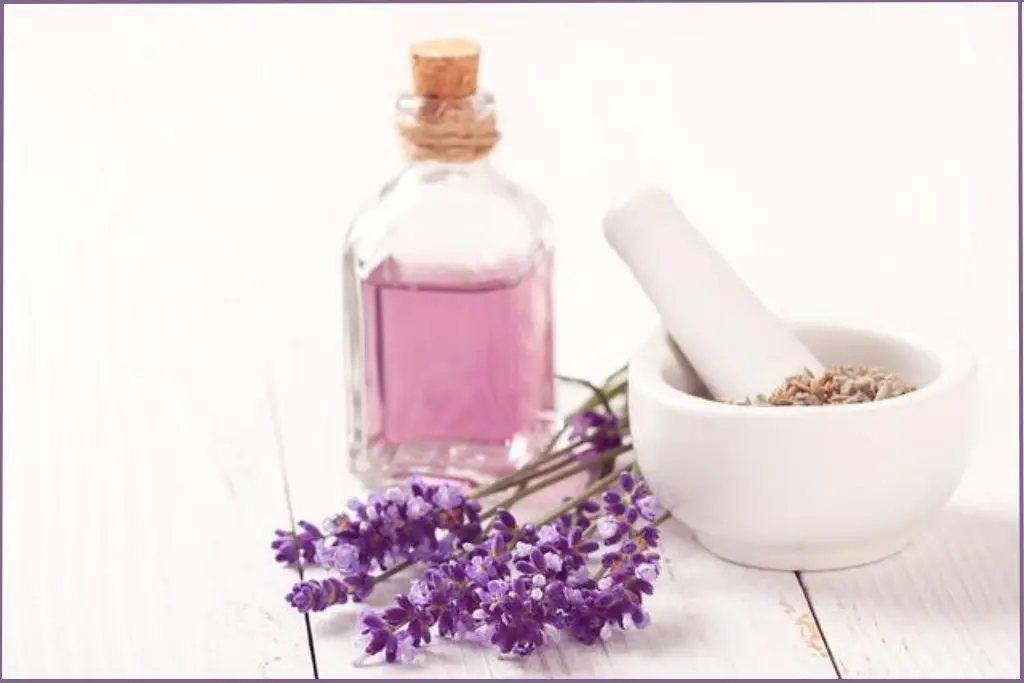
Hydrosols are one of the gentlest and most versatile plant-based products you can add to your daily routine. Whether you’re exploring natural skincare, aromatherapy, or simple ways to enjoy the essence of botanicals, hydrosols offer a soft, approachable starting point.
Top hydrosol benefits include:
Gentle & Skin-Friendly: Hydrosols are water-based and extremely mild. They’re safe to use directly on the skin without dilution, making them ideal for sensitive skin types, children, and even pets.
Hydrating & Cooling: These floral waters help lightly hydrate the skin while offering a refreshing, cooling effect, especially useful in hot climates or after sun exposure.
Ready to Use: No need for measuring or mixing – just spritz, swipe, or blend. Hydrosols can be used straight from the bottle as facial toners, body sprays, or even in clay masks and compresses.
Naturally Aromatic: They carry the subtle scent of the plant they’re distilled from, offering a more delicate aromatic experience than essential oils. This makes them perfect for those who are scent-sensitive or prefer a lighter touch.
Multi-Purpose & Versatile: From skincare to mood-setting room sprays, hydrosols can do it all. They’re easy to integrate into both daily routines and DIY recipes, whether you’re crafting a calming mist or blending a homemade lotion.
Safe for All Ages: Because they’re so gentle, true hydrosols are often recommended for baby care, elderly skin, or pet-friendly environments, with proper plant selection and quality assurance.
Looking for inspiration on how to start using them? Get started with these ideas on ways to use hydrosols in your daily routine for bath, body, and skin care.
How to Choose a Good Quality Hydrosol
Not all hydrosols are created equal. With the rise in popularity of natural skincare and aromatherapy, many lesser-known manufacturers market products labeled as “floral waters” that may not be true hydrosols. Some may even contain synthetic fragrances or preservatives that reduce their purity and effectiveness.
Others may add water to a few drops of essential oil and market these as hydrosols. However, these are not genuine hydrosols. Not only will these not do you any good, but they could even be harmful. Adding water to essential oils shortens the shelf life of the oil and does not dilute the oil sufficiently for topical application.
Keep these tips in mind to ensure you’re buying a high-quality hydrosol:
Look for Steam-Distilled: A true hydrosol is created through steam distillation, the same process used to extract essential oils. Avoid products labeled “floral water” or essential oil mixed with water or alcohol.
Check the Ingredients List: The best hydrosols contain only one ingredient: the plant distillate. For example, a genuine rose hydrosol should list Rosa damascena distillate or rose hydrosol – no added fragrance, alcohol, or preservatives.
Choose Dark Glass Packaging: Light and heat can degrade the quality of hydrosols. Look for products stored in dark amber or cobalt blue glass bottles, which help preserve freshness and protect the delicate plant compounds.
Opt for Organic or Wildcrafted When Possible: While not always essential, organic or wildcrafted hydrosols are often made from plants grown without pesticides or harsh chemicals — a plus if you’re using them directly on your skin.
Buy from Reputable Sources: Choose trusted brands that specialize in aromatherapy, herbal skincare, or plant-based wellness. Look for transparency about sourcing, distillation methods, and freshness.
Keeping these tips in mind will ensure you’re buying a pure, non-diluted hydrosol that brings all the gentle power of plants to your routine without additives or fillers.
Why Plant Therapy Is My #1 Recommended Brand For Buying Hydrosols
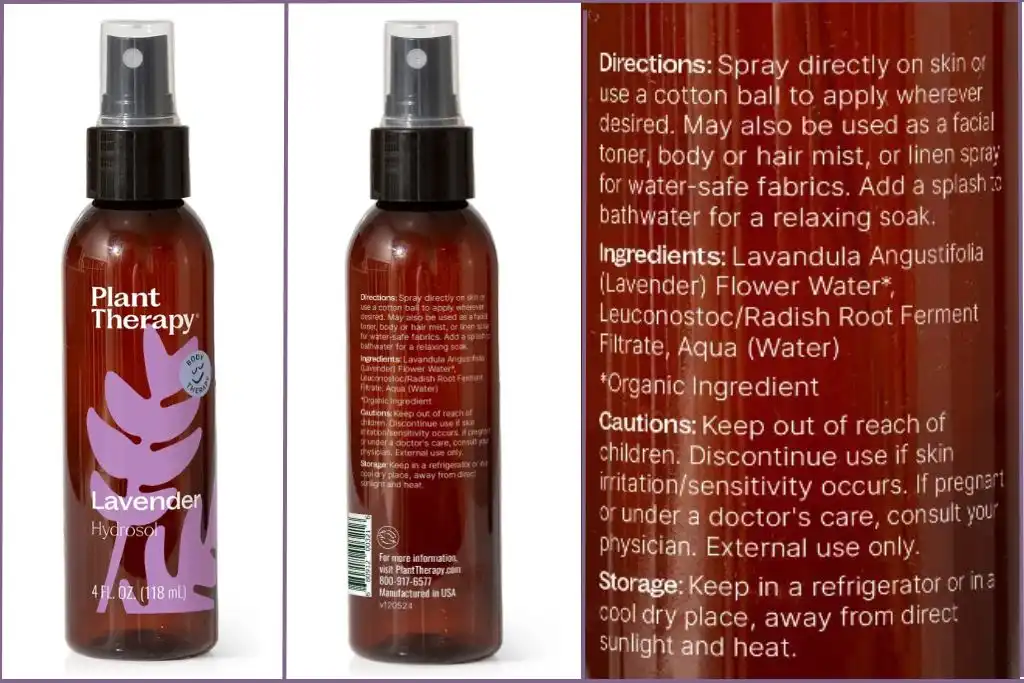
Plant Therapy is my top choice when it comes to buying hydrosols. Their products, from essential oils and diffusers to hydrosols and skincare products, are trusted by aromatherapy experts and everyday users for purity, safety, and transparency.
All Plant Therapy hydrosols are steam-distilled for maximum purity and packaged in dark glass bottles to protect both quality and shelf life. Each batch is clearly labeled and tested, so you know exactly what you’re using.
Take the brand’s lavender hydrosol, for example. It is steam distilled from Lavandula angustifolia and contains 98% organic hydrosol, preserved only with a gentle, plant-based blend – radish root ferment filtrate. This natural, organic preservative does not compromise the quality or potency of the end product.
Plant Therapy brand reviews reflect high customer satisfaction and reliable results for all products, including hydrosols, essential oils, diffusers, and skincare.
Hydrosols offer a gentle bridge between nature and self-care, but quality and mindful choices matter. With Plant Therapy, you get additive-free, expertly crafted hydrosols you can trust for daily routines.
What to Avoid When Buying Hydrosols
With so many “floral waters” on the market, it’s easy to mistake synthetic or watered-down products for true hydrosols.
Steer clear of fragrance waters. These are usually just distilled water mixed with synthetic fragrance or perfume oils. They may smell nice, but they offer none of the plant-based therapeutic benefits of a true hydrosol.
Check the label – if it lists “fragrance” or “parfum,” it’s not a genuine hydrosol.
Easy Ways To Use Hydrosols In Your Daily Routine
Hydrosols fit into modern lifestyles with almost no effort. Their gentle aroma and natural touch make them easy to blend into your favorite routines.
No matter your schedule or style, there’s always room for a fresh spritz of plant-based goodness.
How do you turn these fragrant waters into a simple pleasure every day? Here’s how to bring hydrosols off the shelf and into your personal rituals.
Morning Skincare and Beauty Routines
Start your day with a soft burst of hydration and scent. Hydrosols are ideal for all skin types and work well as part of a gentle morning routine.
- Facial mist: Spray directly on your skin for a dewy, refreshed look before adding moisturizer. Rose and lavender are popular picks for their subtle fragrance and calming touch.
- Toner alternative: Use a cotton pad or your hands to smooth hydrosol onto your face after cleansing. This preps skin for any serums or creams you love.
- Makeup setting spray: Lightly mist your face after applying makeup to help everything blend and set naturally.
Integrating hydrosols into your beauty ritual is quick and clean, and feels a little more luxurious each time.
Midday Mood Boosters
A midday pause often brings the need for a pick-me-up. Hydrosols shine as portable refreshers that require no extra effort.
- Desk spray: Keep a small bottle near your workspace for a quick spritz when you need to clear your mind.
- Body cooling: A splash of peppermint or melissa hydrosol helps you shake off sluggish moments and feel re-energized.
- Travel companion: Slip a mini mist into your bag for use on the go—perfect for planes, cars, or just errands.
These simple rituals can turn an ordinary afternoon into something soothing and mindful.
Personal Rituals for Relaxation
Wind down in the evening with hydrosols tailored to help set the mood for sleep and calm.
- Bedtime mist: Lavender or chamomile hydrosol promotes a serene environment as you settle in for the night.
- Bath boost: Add a few tablespoons of hydrosol to your bathwater for light fragrance and a touch of softness.
- Yoga and meditation: Mist your mat or the air before starting mindful movement or breathing exercises.
Small rituals like these remind you to pause and unwind.
Home and Living Space Refresh
Hydrosols are not just for skin—they’re perfect for your home, too. Their fresh, plant-based aroma works in nearly any room.
- Linen and pillow spray: Lightly mist bedding, towels, or curtains for a gentle, welcoming scent. Rose or chamomile hydrosol brings a hint of calm to your space.
- Air freshener: Swap artificial sprays for a natural hydrosol mist. Spritz rooms after cleaning or before guests arrive.
- Pet-friendly options: Because hydrosols are mild, they can be used around pets (in small, diluted amounts). Try misting pet bedding for a quick refresher.
Turn your home into a peaceful retreat with just a few sprays.
Simple DIY Recipes With Hydrosols
For those who like a hands-on touch, hydrosols work well in basic DIY projects. They are easy to mix and bring a homemade feel to your wellness kit.
Here are a few beginner-friendly ideas:
Room spray – Pour hydrosol into a spray bottle, use alone or mix with a few drops of essential oil for extra scent.
Face mask enhancer – I used lavender hydrosol for this Purple Brazilian Clay Mask recipe, for a gentle skin detox.
Hair mist – Lightly mist hair and scalp for a gentle scent and softness.
Hydrosols let you experiment without worry, and their natural origin keeps things simple and safe.
Incorporating hydrosols into your day is about embracing simple joys. Whether you need a mood lift or a refreshing ritual, hydrosols fit right in without any fuss.
Hydrosol Safety Tips
Hydrosols are mild and generally safe, but to ensure you enjoy their benefits responsibly and without unintended side effects, keep these safety considerations in mind:
Patch-Test Before Use: Even though hydrosols are gentle, it’s wise to test on a small skin area first—especially if you’re prone to sensitivity. Apply a spritz on your inner arm and wait 24 hours to ensure there’s no reaction.
Be Mindful of Storage: Because hydrosols are composed mostly of water and don’t contain strong preservatives, they are more prone to bacterial growth than essential oils. To extend their shelf life, keep them cool, ideally in a dark glass bottle, and refrigerate once opened. Typical shelf life is 6–12 months. Make sure to note the production or expiration date stamped on the bottle.
Use Clean Application Methods: Avoid contaminating the bottle by dipping your fingers or unclean cotton balls inside. Instead, use bottles with spray tops or pour into a small pump bottle for easy, hygienic use with minimum risk of degradation.
Avoid Use Near Eyes or Open Wounds: A mild mist is typically safe for the face, but avoid getting hydrosols in the eyes. And unless the hydrosol is specifically diluted and sterile, avoid using it on deep wounds or burns.
Keep Pet & Plant Safety in Mind: Most hydrosols (like lavender, rose, chamomile) are safe around pets when used as a fine mist. Still, avoid direct contact with the eyes and mucus membranes and do not ingest. When in doubt, check with a vet, particularly for cats or animals with respiratory sensitivities.
How To Store Hydrosols Correctly
The best way to store hydrosols is in a cool, dark environment with a consistent temperature.
Pure hydrosols have a high water content and are preservative-free. Both factors increase the risk of bacterial contamination and shorten the lifespan of the hydrosol.
Storing hydrosols in the fridge preserves the integrity of the components, helping them last longer with their properties and benefits intact. As a bonus, spritzing the cool hydrosol on your face and body can feel very refreshing.
Do not store hydrosols in the freezer. The sub-zero temperature in the freezer can damage the components of the hydrosol.
Why Hydrosols Deserve a Spot in Your Routine
Hydrosols are a beautiful way to bring nature’s gentlest elements into your daily life. Whether you’re drawn to the soft scent of rose, the calm of chamomile, or the cool refreshment of peppermint, there’s a hydrosol that can uplift your senses and support your skincare, without overwhelming your skin or your space.
They’re simple to use, versatile in purpose, and safe for almost everyone. As you explore, remember to choose high-quality, steam-distilled hydrosols from trusted brands like Plant Therapy, and store them with care.
Frequently Asked Questions About Hydrosols
What’s the difference between floral water and hydrosol?
True hydrosols are produced through steam distillation and contain active, water-soluble plant compounds. Many commercial “floral waters” are simply distilled water mixed with synthetic fragrance or essential oils, these don’t offer the same skin-friendly or therapeutic benefits.
Can I make my own hydrosol at home?
Yes, you can, but with a caveat. You could make small-batch hydrosols at home using a pot, a heat-safe bowl, water, ice, and fresh plant material. However, professional steam distillation yields the highest quality. Homemade versions have a shorter shelf life and may lack the purity or stability of professionally distilled versions.
Can I freeze hydrosols?
No, you should never freeze hydrosols. Freezing damages the components and renders the hydrosol unusable.
Can I heat hydrosols?
Hydrosols are sensitive to high heat. If you do need to heat it for a specific purpose, make sure to heat it gently. Do not heat too quickly and do not overheat. High heat damages the delicate components of hydrosols.
How long do hydrosols last?
The shelf life of each hydrosol is different. It depends on the botanicals of that particular hydrosol, its pH level, distillation conditions, storage conditions, and how it is handled. When you buy hydrosols, read the product page to learn more about it.
Which hydrosol is best for the skin?
Lavender Hydrosol has astringent and purifying properties and is suitable for all skin types.
Rose Hydrosol is better suited for combination and oily skin. It is also good for sensitive skin.
Which hydrosol is good for hair?
Rose and Rosemary hydrosols are best for oily hair.
Lavender and Neroli hydrosols are good for dry hair.
Can I use hydrosols in a diffuser?
No, hydrosols are not suitable for ultrasonic or nebulizing diffusers, as they contain water and botanical particles that can damage the device or cause mold buildup. Stick to essential oils for diffusing and use hydrosols as mists or in water-based skincare.
Do hydrosols need preservatives?
Most true hydrosols don’t contain preservatives, but because they’re water-based, they can spoil if not stored properly. Some brands (like Plant Therapy) include a natural preservative like radish root ferment to extend shelf life. If you’re using a hydrosol that lasts beyond 12 months, read the label to check for added preservatives.
Want to learn more about hydrosols? These are excellent and reliable books on the topic.
Hydrosols: The Next Aromatherapy– A comprehensive reference with more than 100 recipes, formulas, and ideas for using hydrosols.
Hydrosol Therapy – The complete guide to working with hydrosols, covering theory as well as practical application ideas.
Essential Waters: Hydrosols, Hydrolats & Aromatic Waters – A brief guide to the healing uses of the floral and herbal waters produced during the process of distilling essential oils
375 Essential Oils and Hydrosols – A guide profiling 375 different essential oils according to botanical family, habit and growth, chemical components, and actions
